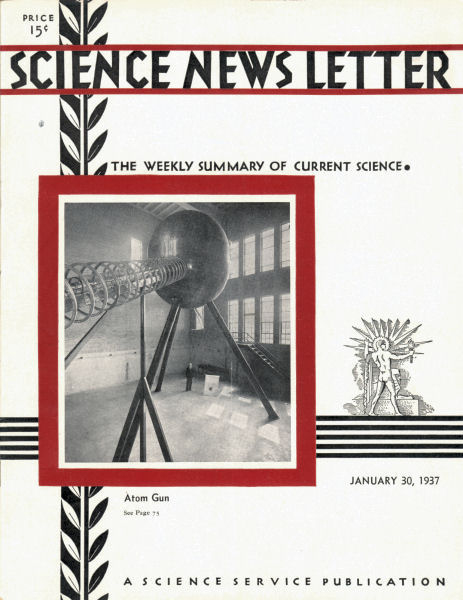From the January 30, 1937, issue

NOTRE DAME UNIVERSITY HAS NEW ATOMIC GUN
An electrostatic type of high-voltage generator with which scientists hope to create the tiny elemental particles known as positrons has now been installed at the physics laboratories of the University of Notre Dame. Under the direction of Prof. G.B. Collins, two graduate students, R.J. Schager and A.L. Vitter, have built the giant apparatus shown on the front cover of this week’s Science News Letter.
Voltage is conveyed up to the large, 12-foot diameter electrode on the belt in the foreground. The accelerating tube down which electrons will be driven by the 1,500,000-volt potential is at the left. The size of the equipment is realized by comparison with the scientist standing below.
NEW HUMAN RELATIVE IN SKULL “OF GREATEST IMPORTANCE”
A prehistoric human skull that has come to light in East Africa provides man with a brand-new relative for his proud old family tree.
Enthusiastically hailing the skull as “of the greatest importance,” Dr. L.S.B. Leakey, noted British anthropologist, gives his opinion that this early African was an entirely different genus of man from any heretofore known.
Dr. Leakey’s verdict, if generally accepted, means that an unsuspected extinct branch of the human race is now known; and that this distinct type of man, low in type, was among a number of genera and species of humans who were on Earth, but who died out, leaving only the species, Homo sapiens, to which all mankind alive belongs.
The skull represents a man who was “a low type of human with some markedly anthropoid characters,” Dr. Leakey declares (Nature, Dec. 26). Primitive and uncouth as this man was, he had his day on Earth surprisingly late. Although this Stone Age African had the beetling-eye ridges like his shambling, clumsy distant “cousin,” Neandertal man, the African represents a generation more than 30,000 years later than Neandertal man’s own characteristic age. Assigning the new discovery to the early or middle Gamblian period of African’s geological history, Dr. Leakey is thereby suggesting that the new-found genus of man existed on Earth somewhere about 30,000 years ago.
“YAWN” AND A BIG STRETCH IMPROVES RAYON FABRICS
Just as a wide-open yawn and a healthy stretch awakens dormant strength in the human body, so textile chemists have discovered that by making acetate rayon (one of the newer artificial silks) “yawn” and then giving it a long stretch, it doubles and triples its strength.
Not only that, but they can make the acetate rayon fabrics more resistant to hot water and soap liquors so that it retains its luster and strength in laundering. A.J. Hall, British textile chemist, made the discovery and has patented the method (No. 1,709,470).







